The Sub-Systems of the global system consists of the following:
– Lateral Sub-System (LS)
– Deep Longitudinal Sub-System (DLS)
– Posterior Oblique Sub-System (POS)
– Anterior Oblique Sub-System (AOS)
The Lateral Sub-System
The lateral sub-system provides frontal plane stabilization and movement. It is comprised of the hip abductor musculature that works synergistically with the lateral flexors of the trunk to the contralateral side. There is also some assisting control from the ipsilateral hip adductors.
Dysfunction of the LS can commonly be a source of back and leg injury.
Muscles involved in the LS include:
- Gluteus Medius
- Gluteus Minimus
- Tensor Fasciae Latae
- Quadratus Lumborum(contralateral)
- Internal Obliques (contralateral)
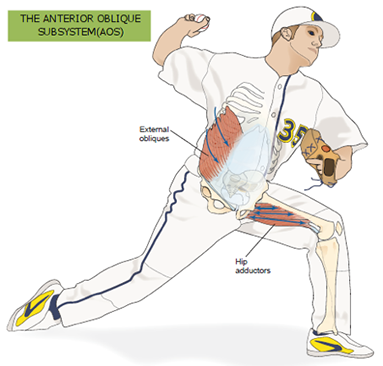
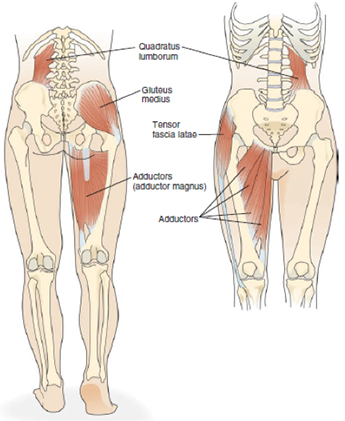
Any sideways movement of the stationary leg as seen with a rugby (or football) player sidestepping to avoid an opponent will activate the gluteus medius, minimus, and TFL to abduct the hip.
The accompanying activation of the lateral flexors to the opposite side causes a slight lateral tilt of the pelvis to assist with the lift of the leg.
With assisted control of the hip adductor complex, the Lateral Sub-System muscles work dynamically to stabilize the pelvis and body over the shifted centre of gravity.
A succeeding sideways plant of the opposite leg would signal immediate activation of the opposite side causes a slight lateral tilt of the pelvis to assist with the lift of the leg.
A succeeding sideways plant of the opposite leg would signal immediate activation of the opposite lateral sub-system.
You can observe this in several activities besides rugby, such as speed skating, American football, and tennis.
The Lateral Sub-System
Deep Longitudinal Sub-System
The deep longitudinal sub-system provides for reciprocal force transmission from the ground to the trunk and back down.
This sub-system’s major roles are to absorb and transfer ground force and resulting kinetic energy, stabilize the ankle, decelerate forward leg movement, and stabilize the spine by resisting trunk flexion.
Muscles involved in the DLS include:
- Tibialis Anterior
- Peroneus Longus
- Bicep Femoris
- Erector Spinae
- Thoracolumbar Fascia
- Sacrotuberous Ligament
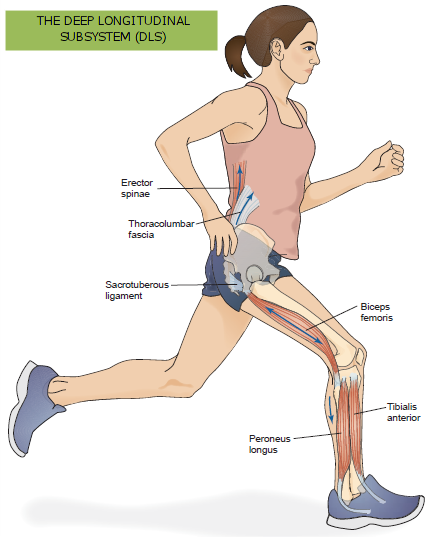
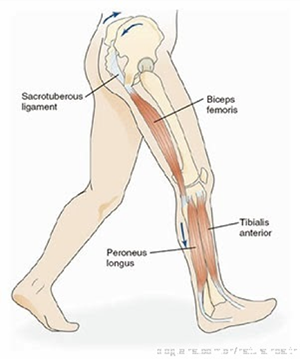
As the leg moves forward during the swing phase when running, the hamstring muscles activate to decelerate the forward leg movement, or hip flexion and knee extension.
The activation of the biceps femoris increases tension in the sacrotuberous ligament, which transfers force across the sacrum; this stabilizes the S.I. joint of the pelvis and allows for force transference up through the erector spinae to also help stabilize the trunk.
The action of the biceps femoris also causes tension through the peroneus longus, which works in concert with the anterior tibialis to stabilize the ankle in preparation for the heel to strike the ground.
Upon heel strike, resulting ground forces and kinetic energy are captured in the thoracolumbar fascia and later used by the posterior oblique system for the propulsion phase of gait.
Deep Longitudinal Sub-System
The Posterior Oblique Sub-System
The posterior oblique sub-system is comprised primarily of the latissimus dorsi and the contralateral glutens. It works synergistically with the Deep Longitudinal Sub-system through its shared use of the connective thoracolumbar fascia.
Muscles involved in the POS include:
- Latissimus Dorsi
- Thoracolumbar Fascia
- Gluteus Maximus
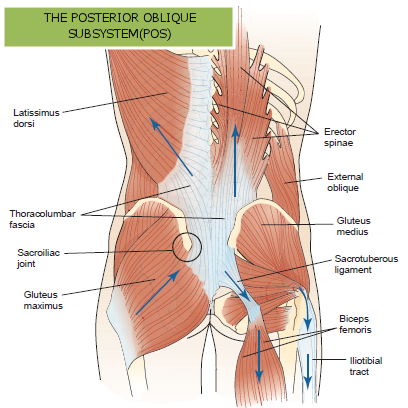
As the leg moves forward in the swing phase of running, the ipsilateral gluteus maximus assists the hamstrings to decelerate hip flexion, while the contralateral latissimus dorsi activates to decelerate forward flexion of the arm.
There is a parallel alignment of the muscle fibres of the gluteus maximus and the contralateral latissimus dorsi. They transfer force across the S.I. joint at a perpendicular angle, which assists to stabilize the pelvis during the impact of heel strike and prepares the entire lumbar-pelvic region for propulsion.
The thoracolumbar fascia then transfers stored kinetic energy to the Posterior Oblique Sub-System, which in turn accelerates or pulls the arm and opposite leg back, which propels the body forward.
The timing of the co-contraction of the Posterior Oblique Sub-System produces tension that again is transferred to the thoracolumbar fascia. This tension assists with continued pelvic and lumbar stabilization, and can be stored for use in the following phases of running or gait, which reduces the metabolic cost.
The POS also is of prime importance in rotational actions such as swinging a bat or golf club, or when throwing a baseball.
The Posterior Oblique Sub-System
The Anterior Oblique Sub-System
The anterior oblique sub-system (AOS) works similarly to the POS, only from an anterior orientation.
Muscles involved in the AOS include:
- Hip Adductors
- External Obliques
- Internal Obliques
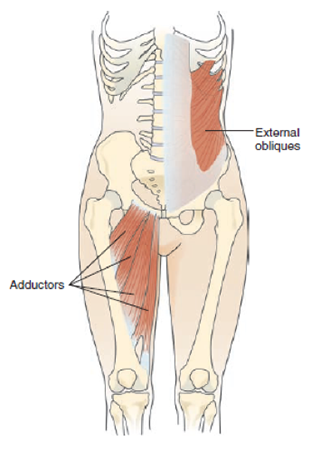

The Anterior Oblique Sub-system functions through the combined actions of the hip adductors along with the contralateral obliques through the parallel alignment of their fibres.
Their close proximity of attachment at the pubis allows for force transference and communication between the aponeurosis insertion of the external oblique and the origins of the pectineus and adductor longus muscles.
These muscles of the Anterior Oblique Sub-system work synergistically to stabilize the body on top of the stance leg while rotating the pelvis for the swing phase of gait.
The Anterior Oblique Sub-system also works with the Posterior Oblique Sub-system to help with optimal positioning of the pelvis and leg to prepare for impact from the succeeding heel strike.
The Anterior Oblique Sub-system, in concert with the Posterior Oblique Sub-system, is also instrumental in accelerating rotational movements such as a baseball pitch.
The Anterior Oblique Sub-System
